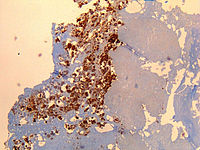
Sero‐detection of Coxiella burnetii infection in cattle, sheep and goats in selected regions of Nepal
Sign Up to like & getrecommendations! Published in 2021 at "Veterinary Medicine and Science"
DOI: 10.1002/vms3.458
Abstract: Abstract Coxiella burnetii, a Gram‐negative bacterium is a zoonotic agent causing coxiellosis in animals. Small ruminants and cattle are the primary reservoirs for human infection. This study was aimed to estimate the sero‐prevalence of C.… read more here.
Keywords: cattle sheep; infection; regions nepal; coxiella burnetii ... See more keywords

Detection of Coxiella burnetii DNA and anti-Coxiella burnetii IgG antibodies in precolostral blood samples of stillborn calves in an endemically infected Holstein dairy herd
Sign Up to like & getrecommendations! Published in 2017 at "Folia Microbiologica"
DOI: 10.1007/s12223-017-0553-4
Abstract: Coxiella burnetii (C. burnetii), an intracellular zoonotic bacterium causing Q fever, occurs widely in cattle herds. After invasion of the pregnant uterus and initial localization in the placenta, active C. burnetii infections may spread to… read more here.
Keywords: precolostral blood; blood samples; coxiella burnetii; stillborn calves ... See more keywords

Coxiella burnetii in dairy goats with a history of reproductive disorders in Brazil.
Sign Up to like & getrecommendations! Published in 2018 at "Acta tropica"
DOI: 10.1016/j.actatropica.2018.04.010
Abstract: Coxiella burnetii, an intracellular bacterium, is the agent of Q fever/coxiellosis, a worldwide zoonosis. Dairy animals are the primary reservoirs of C. burnetii, and although the disease is usually asymptomatic or subclinical, abortion is a… read more here.
Keywords: dairy goats; history reproductive; coxiella burnetii; burnetii ... See more keywords

Evidence of exposure to Coxiella burnetii in neotropical free-living cervids in South America.
Sign Up to like & getrecommendations! Published in 2019 at "Acta tropica"
DOI: 10.1016/j.actatropica.2019.05.028
Abstract: Coxiella burnetii (order Legionellales, family Coxiellaceae), the etiological agent of Q fever, is a pleomorphic, obligate Gram-negative intracellular bacillococcus that can infect humans and animals. Among the mammals hosting this agent, both domestic and wild… read more here.
Keywords: coxiella burnetii; free living; blood samples; evidence exposure ... See more keywords

Coxiella burnetii in camels (Camelus dromedarius) from Algeria: seroprevalence, molecular characterization, and ticks (Acari: Ixodidae) vectors.
Sign Up to like & getrecommendations! Published in 2020 at "Acta tropica"
DOI: 10.1016/j.actatropica.2020.105443
Abstract: Q fever is a widespread zoonotic disease caused by Coxiella burnetii that most commonly infects not only a variety of mammals but also arthropods and in particularly ticks. The aim of this study was to detect… read more here.
Keywords: seroprevalence; coxiella burnetii; burnetii camels; burnetii ... See more keywords

Rat as an overlooked reservoir for Coxiella burnetii: A public health implication.
Sign Up to like & getrecommendations! Published in 2018 at "Comparative immunology, microbiology and infectious diseases"
DOI: 10.1016/j.cimid.2018.11.002
Abstract: Q fever is a zoonosis with a mounting public health concern throughout the world. Rodents have been assumed to be a potential reservoir for Coxiella burnetii, a bacterium which causes Q fever. The current study… read more here.
Keywords: coxiella burnetii; public health; reservoir coxiella;

Seroepidemiological study on Coxiella burnetii and associated risk factors in ruminants at Kurdistan Province, west of Iran.
Sign Up to like & getrecommendations! Published in 2021 at "Comparative immunology, microbiology and infectious diseases"
DOI: 10.1016/j.cimid.2021.101691
Abstract: Q fever is zoonotic disease caused by Coxiella burnetii. Ruminants are the main reservoir of this pathogen, which is often asymptomatic but lead to abortion. This study aims to survey the seroprevalence and risk factors… read more here.
Keywords: ruminants kurdistan; seroprevalence; study; province ... See more keywords

Seroprevalence of hepatitis E virus infection in pigs from Southern Bulgaria: a preliminary report
Sign Up to like & getrecommendations! Published in 2019 at "International Journal of Infectious Diseases"
DOI: 10.1016/j.ijid.2018.11.163
Abstract: s / International Journal of Infectious Diseases 79(S1) (2019) 1–150 63 of the study was to present human clinical cases of Coxiella burnetii infection debuting as FUO. Methods & Materials: The following methods were conducted… read more here.
Keywords: coxiella burnetii; burnetii infection; infection; infectious diseases ... See more keywords

Molecular survey on the occurrence of avian haemosporidia, Coxiella burnetii and Francisellatularensis in waterfowl from central Italy
Sign Up to like & getrecommendations! Published in 2019 at "International Journal for Parasitology: Parasites and Wildlife"
DOI: 10.1016/j.ijppaw.2019.07.008
Abstract: The aim of the present study was to evaluate the occurrence of some avian Haemosporidia, Coxiella burnetii and Francisella tularensis in waterfowl from Tuscany wetlands. One-hundred and thirty-three samples of spleen were collected from regularly… read more here.
Keywords: waterfowl; haemosporidia coxiella; coxiella burnetii; burnetii ... See more keywords

Determination of immunodominant scaffolds of Com1 and OmpH antigens of Coxiella burnetii.
Sign Up to like & getrecommendations! Published in 2019 at "Microbial pathogenesis"
DOI: 10.1016/j.micpath.2018.11.012
Abstract: Today, there is an increasing emphasis on recombinant vaccines to eliminate the side effects of conventional vaccines such as whole-cell bacteria. Query fever is an emerging disease that causes irreparable complications for both humans and… read more here.
Keywords: amino; omph antigens; com1 omph; coxiella burnetii ... See more keywords

Molecular detection and genetic characterization of the potentially pathogenic Coxiella burnetii and the endosymbiotic Candidatus Midichloria mitochondrii in ticks infesting camels (Camelus dromedarius) from Tunisia.
Sign Up to like & getrecommendations! Published in 2019 at "Microbial pathogenesis"
DOI: 10.1016/j.micpath.2019.103655
Abstract: Tick-borne bacteria are considered to be emerging in camels, but data about their occurrence in Tunisian dromedaries and their infesting ticks remain scarce. In this study, 412 camel blood samples and 327 partially engorged ticks… read more here.
Keywords: coxiella burnetii; midichloria mitochondrii; candidatus midichloria; burnetii ... See more keywords